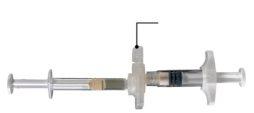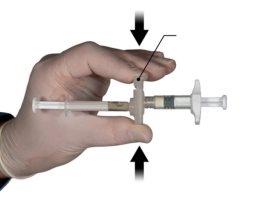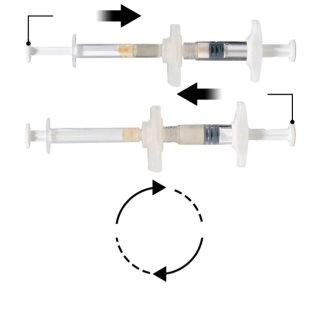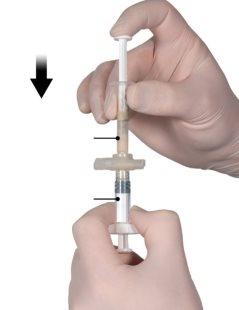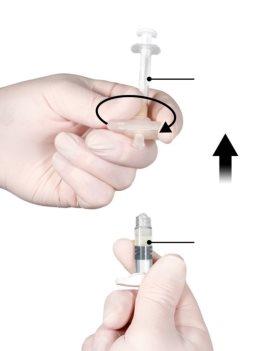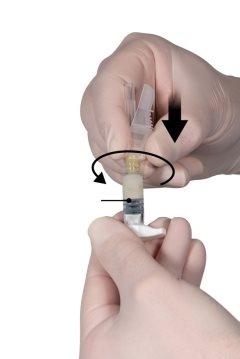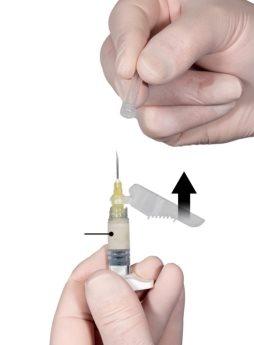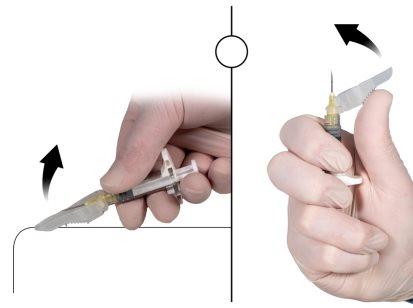
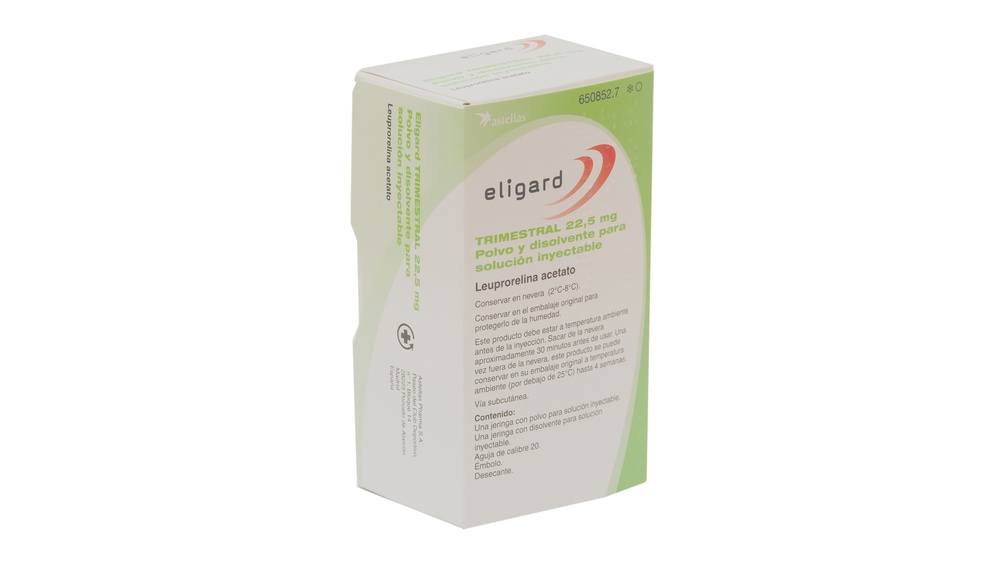
ЭЛИГАРД ТРИМЕСТРАЛЬНЫЙ 22,5 мг ПОРОШОК И РАСТВОРИТЕЛЬ ДЛЯ ПРИГОТОВЛЕНИЯ ИНЪЕКЦИОННОГО РАСТВОРА

Спросите врача о рецепте на ЭЛИГАРД ТРИМЕСТРАЛЬНЫЙ 22,5 мг ПОРОШОК И РАСТВОРИТЕЛЬ ДЛЯ ПРИГОТОВЛЕНИЯ ИНЪЕКЦИОННОГО РАСТВОРА

Инструкция по применению ЭЛИГАРД ТРИМЕСТРАЛЬНЫЙ 22,5 мг ПОРОШОК И РАСТВОРИТЕЛЬ ДЛЯ ПРИГОТОВЛЕНИЯ ИНЪЕКЦИОННОГО РАСТВОРА
Введение
Инструкция: информация для пользователя
Элигард тримесячный 22,5 мг
порошок и раствор для инъекционного раствора
Леупрорелин, ацетат.
Прочитайте внимательно всю инструкцию перед началом использования этого лекарства, поскольку она содержит важную информацию для вас.
|
Содержание инструкции:
- Что такое Элигард тримесячный и для чего он используется
- Что вам нужно знать перед началом использования Элигарда тримесячного
- Как использовать Элигард тримесячный
- Возможные побочные эффекты
- Хранение Элигарда тримесячного
- Содержание упаковки и дополнительная информация
1. Что такое Элигард тримесячный и для чего он используется
Активное вещество Элигарда тримесячного относится к группе аналогов гонадотропин-рилизинг гормона. Эти лекарства используются для снижения производства определенных половых гормонов (тестостерона).
Элигард тримесячный используется для лечения метастатического гормонозависимого рака предстательной железыу взрослых мужчин и в лечении высокорискового неметастатического гормонозависимого рака предстательной железы в комбинации с радиотерапией.
2. Что вам нужно знать перед началом использования Элигарда тримесячного
Не используйте Элигард тримесячный
- Если вы женщина или ребенок.
- Если вы гиперчувствительны (аллергичны)к активному веществу ацетату леупрорелина, к лекарствам с подобной активностью к натуральному гонадотропин-рилизинг гормону или к любым другим компонентам Элигарда тримесячного (перечисленным в разделе 6).
- После хирургического удаления яичек, поскольку в этом случае Элигард тримесячный не приводит к дополнительному снижению уровня тестостерона в крови.
- Как единственное лечение, если вы испытываете симптомы, связанные с давлением на спинной мозг или с опухолью в позвоночнике. В этом случае Элигард тримесячный можно использовать только в комбинации с другими лекарствами для лечения рака предстательной железы.
Предостережения и меры предосторожности
Проконсультируйтесь с вашим врачом, фармацевтом или медсестрой перед началом использования Элигарда тримесячного
- Если у вас есть: любые сердечно-сосудистые заболевания, включая нарушения сердечного ритма (аритмии), или если вы проходите лечение лекарствами для коррекции этих нарушений. Риск нарушений сердечного ритма может увеличиться при использовании Элигарда тримесячного.
- Если у вас затруднения при мочеиспускании. Вас необходимо будет внимательно наблюдать в течение первых недель лечения.
- Если вы начинаете испытывать давление на спинной мозг или затруднения при мочеиспускании. Были сообщения о тяжелых случаях (связанных с другими лекарствами, имеющими подобный механизм действия, как у Элигарда тримесячного) давления на спинной мозг и сужения мочеточников, что может способствовать появлению симптомов, подобных параличу. Если такие осложнения возникают, необходимо начать стандартное лечение.
- Если вы испытываете, в течение двух недель после приема Элигарда тримесячного, внезапную головную боль, рвоту, изменение психического состояния и иногда сердечную недостаточность, сообщите об этом вашему врачу или медицинской команде. Редко, такие случаи были сообщены с другими лекарствами, имеющими подобный механизм действия, как у Элигарда тримесячного, и известны как апоплексия гипофиза.
- Если у вас сахарный диабет(высокий уровень глюкозы в крови). Вас необходимо будет регулярно контролировать во время лечения.
- Лечение Элигардом тримесячным может увеличить риск переломов из-за остеопороза (снижения плотности костей).
- Были сообщения о случаях депрессии у пациентов, использующих Элигард тримесячный. Если вы используете Элигард тримесячный и начинаете испытывать депрессивное состояние, сообщите об этом вашему врачу.
- Были сообщения о случаях сердечно-сосудистых эффектов у пациентов, использующих подобные лекарства, как Элигард тримесячный, что не связано с этими лекарствами. Если вы используете Элигард тримесячный и начинаете испытывать сердечно-сосудистые симптомы, сообщите об этом вашему врачу.
- Были сообщения о случаях эпилептических приступов у пациентов после введения Элигарда тримесячного. Если вы используете Элигард тримесячный и начинаете испытывать эпилептические приступы, сообщите об этом вашему врачу.
- Свяжитесь с вашим врачом немедленно, если у вас сильные или повторяющиеся головные боли, проблемы со зрением, звон в ушах или шум.
- У вас есть жировая дегенерация печени.
Были сообщения о тяжелых кожных высыпаниях, включая синдром Стивенса-Джонсона/токсическую эпидермальную некролиз (СД/ТЭН), в связи с леупрорелином. Прекратите использование леупрорелина и немедленно обратитесь за медицинской помощью, если вы заметите какие-либо симптомы, связанные с этими тяжелыми кожными реакциями, описанные в разделе 4.
Осложнения в начале лечения
В течение первой недели лечения обычно наблюдается кратковременное увеличение мужского полового гормона, тестостерона, в крови. Это может привести к временному ухудшениюсимптомов, связанных с заболеванием, и также к появлению новых симптомов, которые не были испытаны до этого момента. Эти симптомы включают, в частности, боль в костях, нарушения мочеиспускания, давление на спинной мозг или наличие крови в моче. Эти симптомы обычно проходят при продолжении лечения. Если симптомы не проходят, вам необходимо связаться с вашим врачом.
Если вы не улучшаетесь с помощью Элигарда тримесячного
Определенная часть пациентов будет иметь опухоли, которые не чувствительны к снижению уровня тестостерона в крови. Если вы считаете, что эффект Элигарда тримесячного не такой, как ожидается, сообщите об этом вашему врачу.
Использование Элигарда тримесячного с другими лекарствами
Это лекарство может взаимодействовать с некоторыми лекарствами, используемыми для лечения нарушений сердечного ритма (например, хинидин, прокаинамид, амиодарон и соталол) или может увеличить риск нарушений сердечного ритма при использовании с определенными лекарствами (например, метадон, используемый для обезболивания и как часть детоксикации от наркозависимости, моксифлоксацин, антипсихотики, используемые для тяжелых психических заболеваний).
Сообщите вашему врачу или фармацевту, если вы используете или最近 использовали любое другое лекарство, включая те, которые можно купить без рецепта.
Беременность и лактация
Это лекарство противопоказано женщинам.
Вождение и использование машин
Усталость, головокружение и нарушения зрения являются возможными побочными эффектами лечения Элигардом тримесячным или могут возникнуть из-за заболевания. Если вы испытываете эти побочные эффекты, будьте осторожны при вождении или использовании машин.
3. Как использовать Элигард тримесячный
Доза
Следуйте точно инструкциям по введению этого лекарства, указанным вашим врачом или фармацевтом. В случае сомнений проконсультируйтесь с вашим врачом или фармацевтом снова.
Если ваш врач не назначил иначе, это лекарство вводится один раз каждые три месяца.
Инъекционный раствор образует депо активного вещества, из которого происходит непрерывное высвобождение активного вещества, ацетата леупрорелина, в течение трех месяцев.
Дополнительные тесты
Ответ на лечение этим лекарством должен быть проверен вашим врачом путем контроля определенных клинических показателей и определения уровня простатспецифического антигена (ПСА) в крови.
Способ введения
Это лекарство должно вводиться только вашим врачомили медсестрой. Они будут отвечать за его подготовку.
После подготовки Элигард тримесячный вводится в виде подкожной инъекции (инъекции в ткани под кожей). Внутриартериальная (в артерию) или внутривенная (в вену) инъекция должна быть полностью исключена. Как и с другими активными веществами, вводимыми подкожно, место инъекции должно меняться периодически.
Если вы получите больше Элигарда тримесячного, чем необходимо
Поскольку обычно инъекцию вводит ваш врач или квалифицированный персонал, не ожидается передозировка.
Если, однако, была введена большая доза, чем предполагалось, свяжитесь с вашим врачом, чтобы он мог контролировать вас и назначить дополнительное лечение, если необходимо, или проконсультируйтесь с Токсикологической службой. Телефон 91 562 04 20.
Если вы пропустите введение Элигарда тримесячного
Поговорите с вашим врачом, если вы считаете, что пропустили тримесячную инъекцию лекарства.
Эффекты при прекращении лечения Элигардом тримесячным
Как правило, лечение рака предстательной железы этим лекарством является длительным. Следовательно, лечение не должно быть прекращено, даже если симптомы улучшатся или полностью исчезнут.
Если лечение Элигардом тримесячным будет прекращено преждевременно, может произойти ухудшение симптомов, связанных с заболеванием.
Не прекращайте лечение преждевременно без предварительной консультации с вашим врачом.
Если у вас есть какие-либо другие вопросы об использовании этого лекарства, спросите вашего врача, фармацевта или медсестру.
4. Возможные побочные эффекты
Как и все лекарства, Элигард тримесячный может вызывать побочные эффекты, хотя не все люди их испытывают.
Побочные эффекты, наблюдаемые во время лечения Элигардом тримесячным, в основном обусловлены специфическим эффектом активного вещества, ацетата леупрорелина, в частности, увеличением и снижением определенных гормонов. Наиболее часто описываемыми побочными эффектами являются приливы (около 58% пациентов), тошнота, общее недомогание и усталость, а также временное местное раздражение в месте инъекции.
Побочные эффекты в начале лечения
В течение первых недель лечения Элигардом тримесячным симптомы заболевания могут ухудшиться, поскольку в начале лечения наблюдается кратковременное увеличение мужского полового гормона, тестостерона, в крови. Поэтому ваш врач может назначить вам подходящий антиандроген (вещество, ингибирующее действие тестостерона) на начальном этапе лечения, чтобы снизить возможные нежелательные эффекты. (См. также раздел 2 Прежде чем использовать Элигард тримесячный, Осложнения в начале лечения).
Местные побочные эффекты
Местные побочные эффекты, описанные после инъекции Элигарда тримесячного, обычно являются теми, которые часто ассоциируются с подобными препаратами, вводимыми подкожно (препаратами, вводимыми в ткань под кожей). Легкое жжение сразу после инъекции очень часто встречается. Зуд и боль после инъекции, а также синяки в месте инъекции часто встречаются. Покраснение кожи в месте инъекции часто сообщается. Уплотнение тканей и язвы редки.
Эти местные побочные эффекты после подкожной инъекции обычно легкие и имеют короткую продолжительность. Они не повторяются между отдельными инъекциями.
Очень частые побочные эффекты (могут встречаться более чем у 1 из 10 человек)
- Приливы
- Спонтанные кровотечения на коже или слизистых оболочках, покраснение кожи
- Усталость, побочные эффекты, связанные с инъекцией (См. также местные побочные эффекты выше)
Частые побочные эффекты (могут встречаться до 1 из 10 человек)
- Назофарингит (симптомы простуды)
- Тошнота, общее недомогание, диарея, воспаление желудка и кишечника (гastroenteritis/колит)
- Зуд, ночная потливость
- Боль в суставах
- Нерегулярное мочеиспускание (также ночью), затруднения при начале мочеиспускания, боль при мочеиспускании, снижение объема мочи
- Чувствительность молочных желез, воспаление молочных желез, снижение размера яичек, боль в яичках, бесплодие, эректильная дисфункция, снижение размера полового члена
- Ригидность (эпизоды чрезмерного дрожания с высокой температурой), слабость
- Удлинение времени кровотечения, изменения в анализах крови, снижение количества красных кровяных телец/низкий уровень красных кровяных телец
Редкие побочные эффекты (могут встречаться до 1 из 100 человек)
- Инфекция мочевыводящих путей, местная кожная инфекция
- Ухудшение сахарного диабета
- Аномальные сны, депрессия, снижение либидо
- Головокружение, головная боль, нарушения чувствительности кожи, бессонница, нарушения вкуса, нарушения обоняния
- Гипертония (повышение артериального давления), гипотония (снижение артериального давления)
- Затруднение дыхания
- Запор, сухость во рту, диспепсия (плохая пищеварение, симптомы переполнения желудка, боль в желудке, отрыжка, тошнота, рвота, ощущение жжения в желудке), рвота
- Чувство жары, увеличение потливости
- Боль в нижней части спины, мышечные спазмы
- Гематурия (присутствие крови в моче)
- Спазмы мочевого пузыря, частое мочеиспускание, невозможность мочеиспускания
- Увеличение молочной железы у мужчин, импотенция
- Сонливость (летаргия), боль, температура
- Увеличение веса
- Потеря равновесия, головокружение
- Потеря мышечной массы/потеря мышечной ткани после длительного использования
Очень редкие побочные эффекты (могут встречаться до 1 из 1 000 человек)
- Аномальные непроизвольные движения
- Внезапная потеря сознания, обморок
- Вздутие, отрыжка
- Потеря волос, кожная сыпь (прыщи на коже)
- Боль в груди
- Язвы в месте инъекции
Очень редкие побочные эффекты (могут встречаться до 1 из 10 000 человек)
- Некроз в месте инъекции
Неизвестная частота (частота не может быть оценена из доступных данных)
- Изменения на электрокардиограмме (удлинение интервала QT)
- Воспаление легких, легочная болезнь
- Идиопатическая внутричерепная гипертония (повышение внутричерепного давления вокруг мозга, характеризующееся головными болями, двоением в глазах и другими зрительными симптомами, звоном в ушах или шумом).
- Если вы заметите на теле круглые или кольцевидные пятна красноватого цвета, часто с пузырьками в центре, шелушением кожи, язвами во рту, горле, носу, гениталиях и глазах. Эти тяжелые кожные высыпания могут быть предшествованы лихорадкой и симптомами, подобными гриппу (синдром Стивенса-Джонсона/токсическая эпидермальная некролиз).
- Покраснение кожи и сыпь с зудом (токсическая кожная эритема).
- Кожная реакция, вызывающая прыщи или красные пятна на коже, которые могут напоминать мишень, с красным центром, окруженным кольцами более светлого красного цвета (эритема многоформная).
Другие побочные эффекты
Другие побочные эффекты, опубликованные в связи с лечением леупрорелином, активным веществом Элигарда тримесячного, включают отек (накопление жидкости в ткани, проявляющееся как отек рук и ног), легочную эмболию (приводящую к симптомам, таким как одышка, затруднение дыхания и боль в груди), сердечные перебои (перцепция сердечных сокращений), мышечную слабость, озноб, кожную сыпь, потерю памяти и ухудшение зрения. Можно ожидать увеличение потери костной ткани (остеопороза) после длительного лечения Элигардом тримесячным. Из-за остеопороза риск переломов увеличивается.
Редко сообщались тяжелые аллергические реакции, вызывающие затруднение дыхания или головокружение после введения продуктов той же классификации, что и Элигард тримесячный.
Были сообщения о случаях эпилептических приступов после введения продуктов той же классификации, что и Элигард тримесячный.
Сообщение о побочных эффектах
Если вы испытываете любой побочный эффект, проконсультируйтесь с вашим врачом, фармацевтом или медсестрой, даже если это побочные эффекты, которые не указаны в этой инструкции. Вы также можете сообщить об этом напрямую через Испанскую систему фармакологического надзора за лекарствами для человека: www.notificaRAM.es. Сообщая о побочных эффектах, вы можете внести свой вклад в предоставление более полной информации о безопасности этого лекарства.
5. Хранение Элигарда тримесячного
Храните это лекарство в недоступном для детей месте.
Не используйте это лекарство после даты истечения срока годности, указанной на упаковке после CAD. Дата истечения срока годности - последний день месяца, указанного.
Инструкции по хранению
Храните в холодильнике (при температуре между 2°C и 8°C).
Храните в оригинальной упаковке для защиты от влаги.
Этот продукт должен быть при комнатной температуре перед инъекцией. Выньте из холодильника примерно за 30 минут до использования. Как только выньте из холодильника, этот продукт можно хранить в оригинальной упаковке при комнатной температуре (ниже 25°C) в течение 4 недель.
Как только упаковка открыта, продукт необходимо подготовить немедленно и использовать сразу. Только для одноразового использования.
Инструкции по утилизации неиспользованных или просроченных упаковок Элигарда тримесячного
Лекарства не должны выбрасываться в канализацию или мусор. Поместите упаковки и лекарства, которые вам больше не нужны, в пункт SIGRE аптеки. В случае сомнений проконсультируйтесь с вашим фармацевтом, как правильно утилизировать упаковки и лекарства, которые вам больше не нужны. Таким образом, вы поможете защитить окружающую среду.
6. Содержимое упаковки и дополнительная информация
Состав Элигарда триместрального
Активное вещество - ацетат леупрорелина.
Предварительно заполненный шприц (шприц Б) содержит 22,5 мг ацетата леупрорелина.
Другие компоненты - полимолочная кислота (75:25) и N-метил-2-пирролидон в предварительно заполненном шприце с раствором для инъекции (шприц А).
Внешний вид Элигарда триместрального и содержимое упаковки
Порошок и раствор для инъекции.
Доступно в следующих упаковках:
- Упаковка типа термоформованная лоток и стерильная игла калибра 20, вставленная в картонную подставку. Лоток содержит пакет с десикантом и предварительно подключенный шприц, состоящий из:
- шприца А, предварительно заполненного растворителем
- шприца Б, предварительно заполненного порошком
коннектор с кнопкой для шприца А и Б.
- Множественная упаковка, содержащая 2 комплекта шприца с предварительно подключенным шприцем.
Возможно, не все размеры упаковок будут продаваться.
Владелец разрешения на маркетинг
Recordati Industria Chimica e Farmaceutica S.p.A.
Виа Маттео Чивитали, 1
20148 Милан
Италия
Производитель
Recordati Industria Chimica e Farmaceutica S.p.A.
Виа Маттео Чивитали, 1
20148 Милан
Италия
Для получения дополнительной информации об этом лекарстве можно обратиться к местному представителю владельца разрешения на маркетинг:
Casen Recordati, S.L.
Автострада Логроньо, км 13,300
50180 Утебо - Сарагоса
Испания
Это лекарство разрешено в государствах-членах Европейского экономического пространства под следующими названиями:
Австрия: Eligard Depot 22,5 мг
Бельгия: Depo-Eligard 22,5 мг
Кипр: Eligard
Чехия: Eligard
Дания: Eligard
Эстония: Eligard
Финляндия: Eligard
Франция: Eligard 22,5 мг
Германия: Eligard 22,5 мг
Венгрия: Eligard 22,5 мг
Исландия: Eligard
Ирландия: Eligard 22,5 мг
Италия: Eligard
Латвия: Eligard 22,5 мг
Литва: Eligard 22,5 мг
Люксембург: Depo-Eligard 22,5 мг
Нидерланды: Eligard 22,5 мг
Норвегия: Eligard
Польша: Eligard 22,5 мг
Португалия: Eligard 22,5 мг
Словакия: Eligard 22,5 мг
Словения: Eligard 22,5 мг
Испания: Eligard триместральный 22,5 мг
Швеция: Eligard
Дата последнего пересмотра этой инструкции:10/2024
Подробная и актуальная информация о этом лекарстве доступна на сайте Агентства по лекарственным средствам и медицинским изделиям Испании (AEMPS) http://www.aemps.es/
Эта информация предназначена только для медицинских специалистов:
Подождите, пока лекарство достигнет комнатной температуры, вынув его из холодильника примерно за 30 минут до использования.
Сначала подготовьте пациента к инъекции, затем подготовьте лекарство, следуя инструкциям, указанным ниже. Если лекарство не подготовлено с использованием правильной техники, его не следует вводить, поскольку это может привести к отсутствию клинического эффекта из-за неправильного восстановления.
Шаг 1
В чистой зоне откройте лоток, снимая алюминиевую фольгу с угла, чтобы извлечь содержимое. Удалите пакет с десикантом. Извлеките предварительно подключенный шприц (Фигура 1.1) из лотка. Откройте упаковку защитной иглы (Фигура 1.2), снимая бумажную вкладыш. Примечание:шприцы А и Б не должны быть выровнены еще.
Фигура 1.1 Содержимое лотка: предварительно подключенный шприц | Фигура 1.2 Под лотком: защитная игла и колпачок |
|
|
Шаг 2
Держите кнопку коннектора указательным и большим пальцами и нажмите (Фигура 2) до тех пор, пока не услышите щелчок. Два шприца будут выровнены. Не требуется никакого специального положения системы шприцев для активации коннектора. Не сгибайте систему шприцев (пожалуйста, обратите внимание, что часть лекарства может вытечь, если шприцы частично отвинтить).
Фигура 2 |
|
Шаг 3
Держите шприцы в горизонтальном положении, перелейте жидкое содержимое шприца А в порошок ацетата леупрорелина, содержащийся в шприце Б. Хорошо перемешайте продукт в течение 60 циклов, мягко нажимая содержимое обеих шприцев вперед и назад между шприцами (один цикл - это толчок поршня для шприца А и толчок поршня для шприца Б) в горизонтальном положении, чтобы получить однородную и вязкую раствор (Фигура 3). Не сгибайте систему шприцев (пожалуйста, обратите внимание, что часть лекарства может вытечь, если шприцы частично отвинтить).
Фигура 3 |
|
Когда раствор тщательно перемешан, вязкая раствор будет иметь цвет от бесцветного до белого-желтого (который может включать оттенки от белого до желтого).
Важно: после перемешивания немедленно перейдите к следующему шагу, поскольку вязкость продукта увеличивается со временем. Не охлаждайте лекарство после восстановления.
Пожалуйста, обратите внимание: Лекарство должно быть смешано, как описано; встряхивание не даст подходящей смеси.
Шаг 4
После перемешивания держите шприцы вертикально с шприцем Б внизу. Шприцы должны оставаться хорошо соединенными. Перелейте все содержимое в шприц Б (широкий, короткий шприц), нажимая на поршень шприца А и слегка оттягивая поршень шприца Б (Фигура 4).
Фигура 4 |
|
Шаг 5
Пока вы убедились, что поршень шприца А полностью нажат вниз, держите коннектор и отвинтите его от шприца Б. Шприц А останется соединенным с коннектором (Фигура 5). Убедитесь, что содержимое не вытечет, поскольку если это произойдет, игла не будет правильно установлена, когда она будет подключена.
Пожалуйста, обратите внимание: При подготовке может остаться большая воздушная пузырь или несколько небольших - это допустимо. Пожалуйста, не удаляйте воздушные пузырьки из шприца Б в этот момент, поскольку лекарство будет потеряно!
Фигура 5 |
|
Шаг 6
- Держите шприц Б в вертикальном положении и держите белый поршень назад, чтобы не потерять лекарство.
- Зафиксируйте защитную иглу на шприце Б, держа шприц Б и мягко поворачивая иглу по часовой стрелке, примерно на три четверти поворота, пока игла не будет зафиксирована (Фигура 6).
Не перетягивайте, поскольку конус иглы может треснуть, и лекарство может вытечь во время инъекции. Колпачок защитной иглы также может быть поврежден, если игла будет слишком сильно закручена.
Лекарство не должно быть использовано, если конус иглы треснул, поврежден или если содержимое вытекло. Поврежденную иглу не следует заменять или ремонтировать, и лекарство не должно быть введено. Все элементы устройства для введения должны быть утилизированы безопасно.
Если конус иглы поврежден, лекарство должно быть заменено на новое.
Фигура 6 |
|
Шаг 7
Немедленно перед введением отодвиньте защитный колпачок от иглы и снимите защитный колпачок иглы (Фигура 7).
Важно: не манипулируйте механизмом защитной иглы перед введением. Если игла, кажется, повреждена или имеет утечки, продукт не должен быть использован. Поврежденную иглу не следует заменять, и лекарство не должно быть введено. В случае повреждения иглы используйте другой комплект Элигарда.
Фигура 7 |
|
Шаг 8
Перед введением удалите любую большую воздушную пузырь из шприца Б. Введите лекарство подкожно, держа защитный колпачок от иглы.
Процедура введения:
- Выберите место инъекции на животе, верхней части ягодиц или в другом месте с достаточным количеством подкожной ткани, не имеющей избыточного пигмента, узлов, поражений или волос и не использованной недавно.
- Очистите область места инъекции с помощью салфетки с алкоголем (не включена).
- Используя большой и указательный пальцы, зажмите и соберите кожу вокруг места инъекции.
- Используя свою доминирующую руку, вставьте иглу быстро под углом 90 градусов относительно поверхности кожи. Глубина проникновения будет зависеть от количества и ширины подкожной ткани и длины иглы. После введения иглы отпустите кожу.
- Введение лекарства, медленно и равномерно нажимая на поршень, и нажмите на поршень до тех пор, пока шприц не будет пустым. Убедитесь, что вы ввели всю дозу лекарства из шприца Б, прежде чем удалить иглу.
- Удалите иглу быстро под тем же углом 90 градусов, который использовался для введения, сохраняя давление на поршень.
Фигура 8
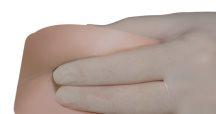
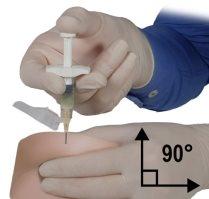
Шаг 9
После инъекции заблокируйте механизм безопасности, используя любой из методов активации, упомянутых ниже.
- Закрытие на плоской поверхности
Нажмите защитный колпачок с помощью скользящего механизма вниз, на плоской поверхности (Фигура 9а), чтобы закрыть иглу и заблокировать колпачок.
Проверьте положение блокировки по слышимому и ощутимому щелчку. Положение блокировки полностью закроет кончик иглы.
- Закрытие большим пальцем
Поместив большой палец на защитный колпачок (Фигура 9б), закройте кончик иглы и заблокируйте колпачок.
Проверьте положение блокировки по слышимому и ощутимому щелчку. Положение блокировки полностью закроет кончик иглы.
Фигура 9а Закрытие на плоской поверхности | Фигура 9б Закрытие большим пальцем |
|
После блокировки защитного колпачка немедленно утилизируйте иглу и шприц в уполномоченном контейнере для острых предметов.

Сколько стоит ЭЛИГАРД ТРИМЕСТРАЛЬНЫЙ 22,5 мг ПОРОШОК И РАСТВОРИТЕЛЬ ДЛЯ ПРИГОТОВЛЕНИЯ ИНЪЕКЦИОННОГО РАСТВОРА в Испании в 2025 году?
Средняя цена на ЭЛИГАРД ТРИМЕСТРАЛЬНЫЙ 22,5 мг ПОРОШОК И РАСТВОРИТЕЛЬ ДЛЯ ПРИГОТОВЛЕНИЯ ИНЪЕКЦИОННОГО РАСТВОРА в ноябрь, 2025 года составляет около 301.02 евро. Финальная стоимость может зависеть от региона, конкретной аптеки и рецептурного статуса. Для точной информации лучше проверить онлайн или в ближайшей аптеке.
- Страна регистрации
- Средняя цена в аптеках301.02 EUR
- Активное вещество
- Требуется рецептДа
- Производитель
- Информация носит справочный характер и не является медицинской рекомендацией. Перед приемом любых препаратов проконсультируйтесь с врачом. Oladoctor не несет ответственности за медицинские решения, принятые на основе этого контента.
- Аналоги ЭЛИГАРД ТРИМЕСТРАЛЬНЫЙ 22,5 мг ПОРОШОК И РАСТВОРИТЕЛЬ ДЛЯ ПРИГОТОВЛЕНИЯ ИНЪЕКЦИОННОГО РАСТВОРАФорма выпуска: ИНЪЕКЦИОННЫЙ РАСТВОР, 42 мгАктивное вещество: leuprorelinПроизводитель: Accord Healthcare S.L.U.Требуется рецептФорма выпуска: ИНЪЕКЦИОННЫЙ РАСТВОР, 45 мгАктивное вещество: leuprorelinПроизводитель: Recordati Industria Chimica E Farmaceutica S.P.A.Требуется рецептФорма выпуска: ИМПЛАНТ, 5 мгАктивное вещество: leuprorelinПроизводитель: Sandoz Farmaceutica S.A.Требуется рецепт
Аналоги ЭЛИГАРД ТРИМЕСТРАЛЬНЫЙ 22,5 мг ПОРОШОК И РАСТВОРИТЕЛЬ ДЛЯ ПРИГОТОВЛЕНИЯ ИНЪЕКЦИОННОГО РАСТВОРА в других странах
Лучшие аналоги с тем же действующим веществом и терапевтическим эффектом.
Аналог ЭЛИГАРД ТРИМЕСТРАЛЬНЫЙ 22,5 мг ПОРОШОК И РАСТВОРИТЕЛЬ ДЛЯ ПРИГОТОВЛЕНИЯ ИНЪЕКЦИОННОГО РАСТВОРА в Польща
Аналог ЭЛИГАРД ТРИМЕСТРАЛЬНЫЙ 22,5 мг ПОРОШОК И РАСТВОРИТЕЛЬ ДЛЯ ПРИГОТОВЛЕНИЯ ИНЪЕКЦИОННОГО РАСТВОРА в Україна
Врачи онлайн по ЭЛИГАРД ТРИМЕСТРАЛЬНЫЙ 22,5 мг ПОРОШОК И РАСТВОРИТЕЛЬ ДЛЯ ПРИГОТОВЛЕНИЯ ИНЪЕКЦИОННОГО РАСТВОРА
Консультация по дозировке, побочным эффектам, взаимодействиям, противопоказаниям и продлению рецепта на ЭЛИГАРД ТРИМЕСТРАЛЬНЫЙ 22,5 мг ПОРОШОК И РАСТВОРИТЕЛЬ ДЛЯ ПРИГОТОВЛЕНИЯ ИНЪЕКЦИОННОГО РАСТВОРА – по решению врача и с учетом местных правил.





